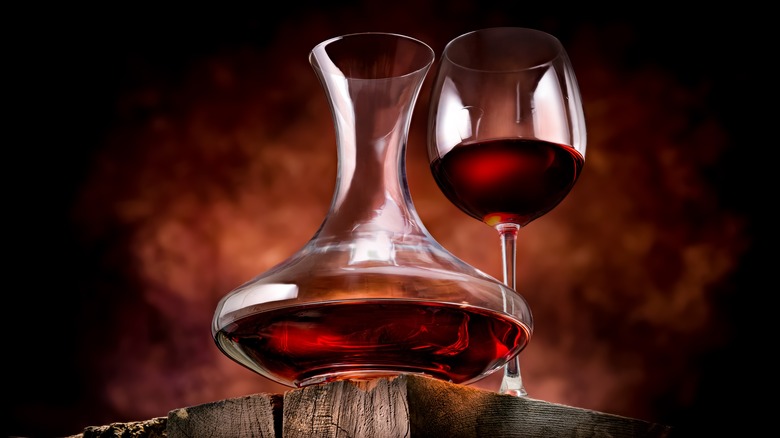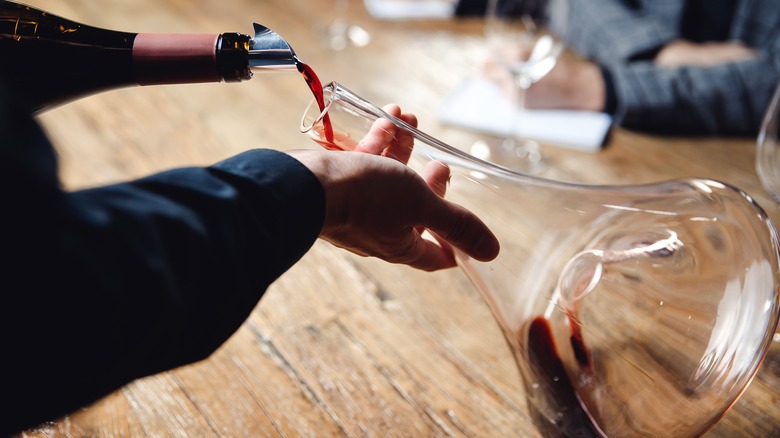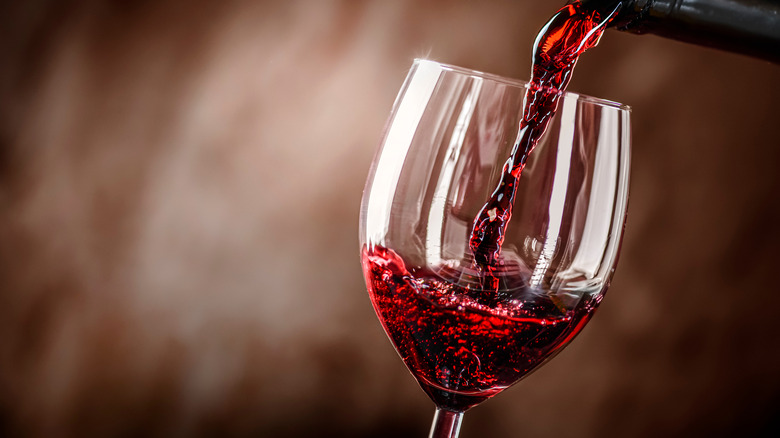The Inexpensive Wine You Should Still Put In The Effort To Decant
Decant is more than just a wine term you try and cram before you go on a date. It's a satisfying, simple extra step that adds some ritual to enjoying a bottle of wine. According to MasterClass, decanting is a slow pour into another vessel. In the wine's case, a proper decanter has a broad shape that maximizes aeration as the wine swirls down its neck. If transferred properly, any sediment that's collected over time will remain in the bottle. Sediment is perfectly safe to consume, but it's not a good look and might taste pretty strange. It's also a perfect opportunity to strain out bits of a broken cork.
Aside from that, agitation allows oxygen into the wine. This step is often referred to as letting the wine breathe, per MasterClass. That breath of fresh air has a positive impact on flavor. The agitation, or aeration, also gives any off-tasting gasses a chance to dissipate. Those gasses can form while the wine is locked in the anaerobic bottle for so long.
Decanting also takes the edge off of a wine's tannins, which are the molecules that create a drying sensation in our mouths. This is common with red wines, which spend more time in contact with the stems, seeds, and skins of the grapes, per MasterClass.
Affordable cabs are an ideal decanting candidate
Aside from sparkling wines, many bottles will benefit from decanting. MasterClass explains that there are some wines that should, no matter what, be decanted. They include malbec, shiraz, and cabernet sauvignon. The wines from Bordeaux and Burgundy also require decanting, per MasterClass. A perfect candidate would be something like Costco's highly heralded new cabernet.
To decant, you want to start with a bottle that's been upright for at least one day. That's enough time for the sediment to collect at the bottom of the bottle. After removing the cork, tilt both the wine bottle and decanter towards each other and pour slowly. Be sure to not tilt the bottle too steeply and send any sediment into the decanter. Stop pouring as soon as you see any sediment enter the neck of the bottle. Even if you don't see any, it's a good idea to leave a small amount, about half an ounce, in the bottle, just in case.
How long you decant is determined by a few variables but Wine Folly has summed it up with a useful chart to guide your patience for the ultimate expression of your wine.
No decanter? No problem
If you're sold on decanting but aren't up to splurging on a decanter, there are other ways. Advanced Mixology's YouTube offers a proper wine glass as the best decanter in a pinch. Their shape makes them something of a handheld, individually sized decanter. Pour your glass early and give it a swirl before drinking.
They go on to explain a few different techniques that achieve similar results to a proper decanter. These methods range from fairly obvious like, a large glass vase or pitcher, to the absurd, like a fish bowl. In the end, a pair of almost any container can substitute for a decanter. They suggest pouring the wine back and forth a few times and giving it a moment's rest before drinking.
If you think you need a mechanical advantage, there's always the blender. Yes, you can pulse the wine in a blender a few times for something that's been christened hyperdecanting, according to Town & Country. This aggressive form of aerating the wine will certainly hasten the aging process and impact the flavor of the wine.


